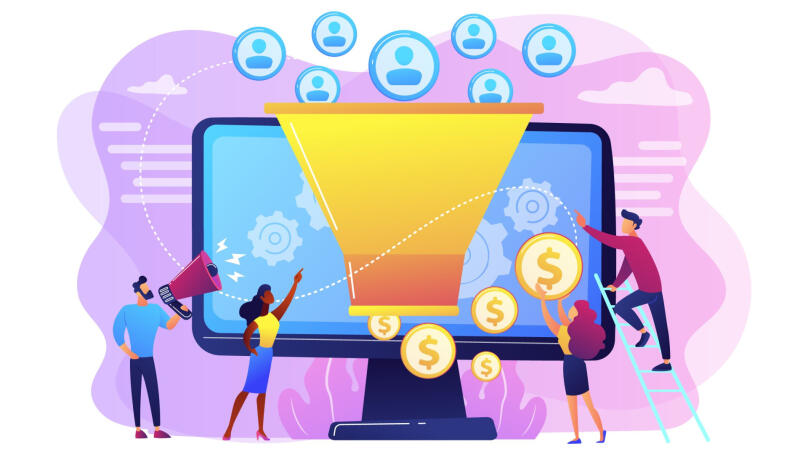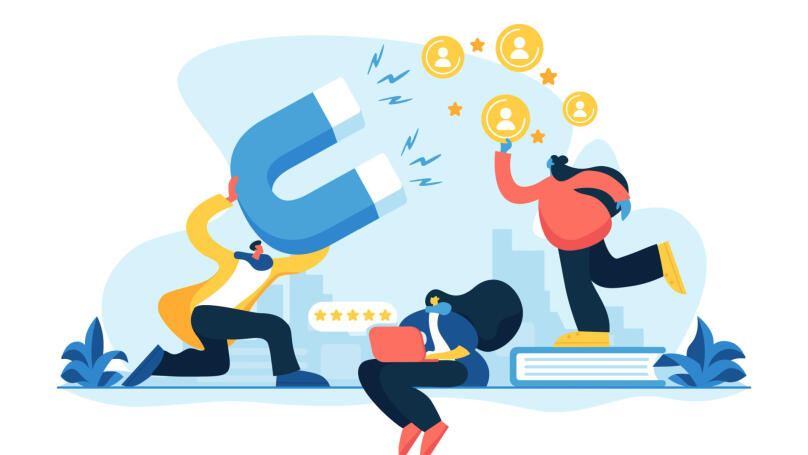Lead

What is a lead?
A lead is a potential customer who can buy something, or a contact used in the sales funnel that can become a connection with a potential customer. Lead generation is the process of getting leads using various tools. For example, you can use online chats on the website, adverts, and forms to capture users already leaving the page. You can also attract leads through cold calls - this method is relevant for sales, but not marketing. Simply put, leads are real users who have expressed interest in buying or can express it. The meaning of this term, by the way, can vary slightly depending on the sphere in which it gets used. So, for example, there are leads in sales and leads in marketing, which are two different things.
What are leads in marketing?
Leads in marketing are contacts that the user sends through a special form on a website or any other platform. They can leave their contacts in a paper form in a shop, which will also be considered a lead. Leads in marketing have their name - Marketing Qualified Leads, or MQL. Moreover, leads in marketing get divided by stages of the sales funnel:
- Product Familiarisation. The lead does not know about the product and their need for it, but may potentially be interested in buying it. It is the stage where we encounter cold leads.
- Potential Interest. The lead is already looking for information about the product, studying offers and competitors.
- Product Selection. The lead is sure they need the product but wants to choose the best offer and compare it with competitors. Here, we will see warm leads, slightly "warmed" to purchase.
- Application to buy the product. At this stage, the lead wants to buy your product, communicating specifically through an application. The customer has a need that your offer covers, and they want to fulfil this need. Hot leads can be found at this stage of the funnel. "Hot" means so "warmed up" to buy that they are willing to consider an increase in cost, for example, delivery time, just to get the product.
So, in Internet marketing, leads are any data that allows you to set up communication with the user. This data can be an email address, phone number, online chat, or contacts (up to the person's address) received after ordering a product. A lead in marketing usually has minimal data about the customer. They are often uploaded to a special CRM system, where sales managers can take them for processing. But first, leads are getting scored: how interesting are they for the company? Will they help to increase sales or average cheques?
What are leads in sales?

A lead in sales is a specific customer who can make a purchase. It is not an abstract phone number but a real person behind it. Leads in sales also have their name - "Sales Qualified Lead," or SQL. How does a lead get to the sales department? It's simple: marketers pass contacts of people interested in buying to sales managers, and managers start to communicate with these people. It is the usual lead processing done in every major company. Simultaneously, sales managers can conduct their lead prospecting; we'll discuss it and its principles later.
A lead's quality indicator is their readiness to make a purchase. But this assessment is conditional because a person who subscribed to your shop's newsletter may be many times more interested in your products than someone who added goods to the basket and closed the tab with the site or expressed a desire to buy a product, and then abruptly changed their mind. You can only assess the quality of a lead through personal contact - that's why we need sales managers who work on this issue and can expertly understand how to convince a person to buy.
Sales leads are divided into several types:
- Cold leads. These are all potential customers who do not yet need to buy. For example, a customer saw your offer to buy a house in a cottage community in advertising. They have thought about buying a home, but in long-term. They don't need to buy a house here and now or in the near future.
- Warm leads. These leads realise they would like to buy a product, but don't yet know who to buy from. For example, the client has already decided to buy a house in a cottage village and is now choosing which village they would like to consider for living in the future.
- Hot leads. A hot lead is when a client wants to buy your product here and now. Or a little later, but they want and are ready to overpay for the product. For example, the client likes the village where you sell houses so much that they have already picked a particular home, imagined how they will enter it and how to decorate and furnish it. They already know how they will arrange a house-warming party and will call their relatives to visit or get a dog. They are, therefore, ready to buy the house right now.
Sales leads are also often divided by source of attraction:
- Spears. People who buy a product after a live contact from the sales team. For example, a sales manager encountered a potential buyer at a business conference. They got to talking and decided to discuss the possibility of a purchase. The lead was likely warm and was already considering purchasing the product. Or the person may have already been offered something, such as a free masterclass or attendance at an online training course, and may have agreed to it. It would also be considered a lead of this type.
- Seeds. People who came to you through a recommendation. For example, a client may have been recommended to you by a friend or colleague. The client comes to you, makes sure your offer suits them, studies the product and its quality, and becomes a regular customer.
- Nets. People who came to you through internet marketing tools - lead collection channels. They may have clicked on your adverts or lead magnets, followed a link from a search engine, found adverts within materials on various websites, or, in general, somehow stumbled upon you and decided that they want to buy your products.
You can attract customers through the overall work of marketing and sales managers. Of course, some leads will never become potential customers: you may lose their data because of a wrong email address or phone number, incorrectly distribute customers between managers and forget that you had additional leads, or generally perceive a lead not as a lead but as a simple user with no interest in your product and pass over them.
Why do you need leads?
Why do you need lead generation in the first place? A lead is a potential customer who can become your regular customer. Without leads, business development will be impossible - how can you develop if you don't have new customers? Your customers leave and don't come back, and you don't know how to keep them? Leads are a crucial indicator of successful project development.
Types of leads

How do leads differ from each other? And how does a lead differ from a conversion? Let's get to the bottom of it. Marketers consider a lead to be a user who made a minimum target action, while conversion is the percentage of users who made this action from the total number of users who visited the site or creative. Now that we've figured out how conversions differ from leads, let's look at the differences between leads.
- Targeted leads. They fit your buying criteria - they have money for your product, live near where you provide services, or have a need you're closing.
- Non-targeted leads. They are not interested in your product - they may be interested in a product you don't have, or they may come to your site by accident. Non-targeted leads can become targeted leads.
- Cold leads. As we said, they are not ready to buy and don't know the product well. It would be best to work with them using marketing tools: mailings, push notifications, and text messages.
- Warm leads. They are interested in the product category but are still comparing it with competitors, possibly needing counselling. They are getting warmed up with offers and promotions, but not persuasive advertising. You must gently remind them about yourself, run retargeting in the lead collection channels, and show visitors personalised offers.
- Hot leads. They want to buy your product or service and may need advice on using it and payment options. The sales team intercepts them: they have high value because they are ready to buy the product and may trade off something (like cost).
Lead management and how to handle leads
So, how do you work with leads? How do you collect them? Well, let's consider ways of working with them and attracting them.
- Lead forms. These are forms on the site. They can offer, for example, to calculate the cost. The client must complete the form and enter their first and last name, phone number or email address. After that, a price will come to the user's email.
- Chatbots. These are bots for consulting website visitors. They answer users' questions and are on each screen with a small button which cannot be closed. User data gets passed to managers - and then they get into the lead distribution to sales specialists.
- Lead magnets. These are free snippets of your main product or specially created products to attract users. A user passes on their contacts and receives a lead magnet in exchange. Their contacts are then passed on to managers offering the customer to buy something.
- Call-back forms offer to order a free call-back. In this case, such a form collects contacts of potential customers and passes them on for further use as part of marketing tools.
How do you calculate the cost of a lead?
The cost per lead is the advertising budget divided by the number of leads. The metric, called Cost Per Lead, or CPL, is actively used in marketing.
Lead generation and how to attract leads

Lead generation is about attracting and collecting leads, prospecting for customers, and encouraging potential customers to buy. For lead generation, you need to study your target audience, draw up a portrait of the potential customer, figure out how to attract them to your product and plan marketing activities that will help tell your audience about you. Then, you will need to buy advertising and targeting, set up multiple channels to reach your audience and develop creatives that will work and test them. In general, the marketer will have something to do at their leisure.
Everyone needs lead generation. It will be helpful for online businesses because it will be easier to establish the first contact with leads from sales managers than with a cold audience and offline projects. After all, you can send customers emails and text messages about your new products and promotions. Moreover, lead generation will help employees, whose income depends on the number of attracted customers, to get their salary.
What are the stages of lead generation?
Firstly, you talk about the product or service. First, the user learns the information and then decides to buy. Convincing the potential customer that the product or service could potentially interest them is essential at this stage. However, you don't need to sell "head-on" from the beginning because it won't work.
Secondly, you form a desire to buy this product or service. The client becomes more interested. They visit the website, visit the shop or restaurant, and check out the project's social media.
Thirdly, you help the client to compare products. Allow comparing your products with other people's products, or write immediately about how you are better than your competitors. Many businesses do this, and it works. Your product must have substantial benefits that you can highlight for the customer.
Fourthly, you notice the customer's interest and collect their contacts. It's simple - you need to set up an advert that will 'catch up' with the customer and show them that they can quickly purchase whatever they need to solve their need from you. Businesses go offline, get published in newspapers, put up their adverts or buy billboards to get in front of the customer. Even mentioning a speaker on a podcast can remind the customer they wanted to purchase from you, for example, a garden gnome or a counselling session with a therapist.
The customer's contacts need to be passed on for processing. For example, a sales manager, or a specialist who will advise the client on a service, could write to them. Ensure that the forms for filling out customer contacts work correctly, are not located near adverts on the site or distracting videos, have a call to action and are not overly cluttered with elements. We also advise including field completion error indicators, a minimal captcha, a header, and a final notification that says the form has been submitted.
Conclusion
So, we have learnt that a lead is a potential customer interested in buying your product or service. They leave their details in any form and start getting considered a lead. Depending on their desire to buy your product, they can be hot, warm, or cold. Leads are attracted with the help of marketing tools, advertising, targeting, and company mentions in various media. They cost different amounts of money, and the most expensive are considered to be hot target leads, i.e. people who want to buy your product specifically. They are "warmed up" to pay a little more money for it than they could and have the opportunity to purchase this product. Leads help to expand your business, increase revenue, and boost the average cheque. A business cannot exist without them; therefore, leads are an essential item to analyse for any marketer and entrepreneur.
You can use contact collection forms for costing, feedback, and free call-back forms to learn how to deal with leads. Then, you should send an email or a text message to the collected contacts about your promotions, discounts and new offers. As the newsletter evolves, you'll understand what your customers are most interested in and be able to offer more personalised items.























